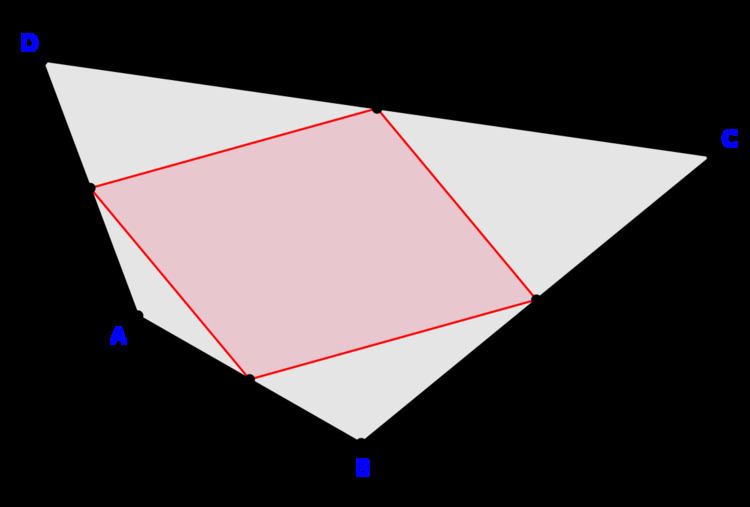 | ||
Varignon's theorem is a statement in Euclidean geometry, that deals with the construction of a particular parallelogram, the Varignon parallelogram, from an arbitrary quadrilateral (quadrangle). It is named after Pierre Varignon, who published it in 1731.
Contents
Theorem
The midpoints of the sides of an arbitrary quadrilateral form a parallelogram. If the quadrilateral is convex or reentrant, (the quadrilateral is not a crossing quadrangle) then the area of the parallelogram is half the area of the quadrilateral.
If one introduces the concept of oriented areas for n-gons, then the area equality above also holds for crossed quadrilaterals.
The Varignon parallelogram exists even for a skew quadrilateral, and is planar whether the quadrilateral is planar or not. The theorem can be generalized to the midpoint polygon of an arbitrary polygon.
Proof
Varignon's theorem is easily proved as a theorem of affine geometry organized as linear algebra with the linear combinations restricted to coefficients summing to 1, also called affine or barycentric coordinates. The proof applies even to skew quadrilaterals in spaces of any dimension.
Any three points E, F, G are completed to a parallelogram (lying in the plane containing E, F, and G) by taking its fourth vertex to be E − F + G. In the construction of the Varignon parallelogram this is the point (A + B)/2 − (B + C)/2 + (C + D)/2 = (A + D)/2. But this is the point H in the figure, whence EFGH forms a parallelogram.
In short, the centroid of the four points A, B, C, D is the midpoint of each of the two diagonals EG and FH of EFGH, showing that the midpoints coincide.
A second proof requires less algebra. By drawing in the diagonals of the quadrilateral, we notice two triangles are created for each diagonal. And by the midpoint theorem, the segment containing two midpoints of adjacent sides is both parallel and half the respective diagonal. Since two opposite sides are equal and parallel, we have that the quadrilateral must be a parallelogram.
From the second proof, we can see that the sum of the diagonals is equal to the perimeter of the quadrilateral formed. Also, we can use vectors 1/2 the length of each side to first determine the area of the quadrilateral, and then to find areas of the four triangles divided by each side of the inner parallelogram.
Properties
A planar Varignon parallelogram also has the following properties:
In a convex quadrilateral with sides a, b, c and d, the length of the bimedian that connects the midpoints of the sides a and c is
where p and q are the length of the diagonals. The length of the bimedian that connects the midpoints of the sides b and d is
Hence
This is also a corollary to the parallelogram law applied in the Varignon parallelogram.
The lengths of the bimedians can also be expressed in terms of two opposite sides and the distance x between the midpoints of the diagonals. This is possible when using Euler's quadrilateral theorem in the above formulas. Whence
and
Note that the two opposite sides in these formulas are not the two that the bimedian connects.
In a convex quadrilateral, there is the following dual connection between the bimedians and the diagonals:
Special cases
The Varignon parallelogram is a rhombus if and only if the two diagonals of the quadrilateral have equal length, that is, if the quadrilateral is an equidiagonal quadrilateral.
The Varignon parallelogram is a rectangle if and only if the diagonals of the quadrilateral are perpendicular, that is, if the quadrilateral is an orthodiagonal quadrilateral.
If a crossing quadrilateral is formed from either pair of opposite parallel sides and the diagonals of a parallelogram, the Varignon parallelogram is a line segment traversed twice.
